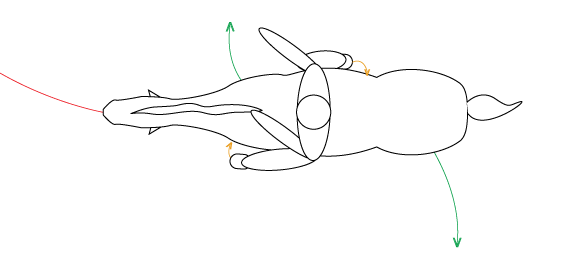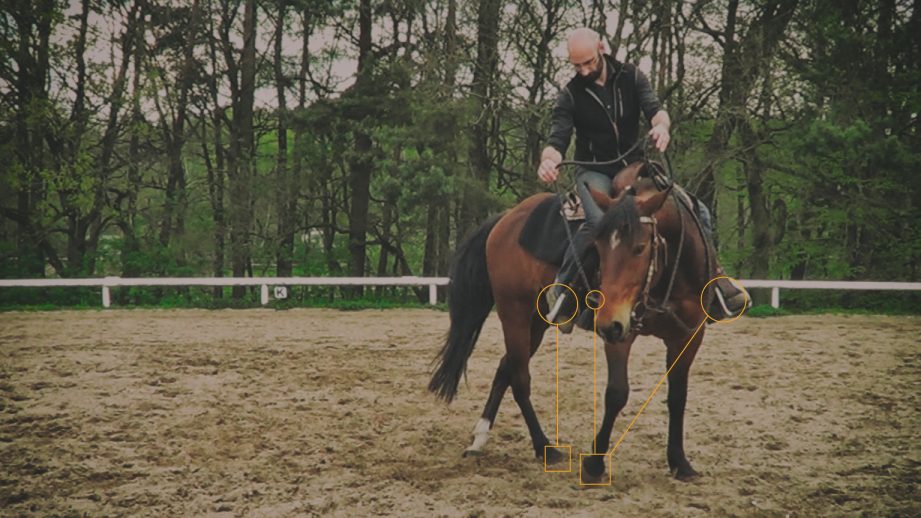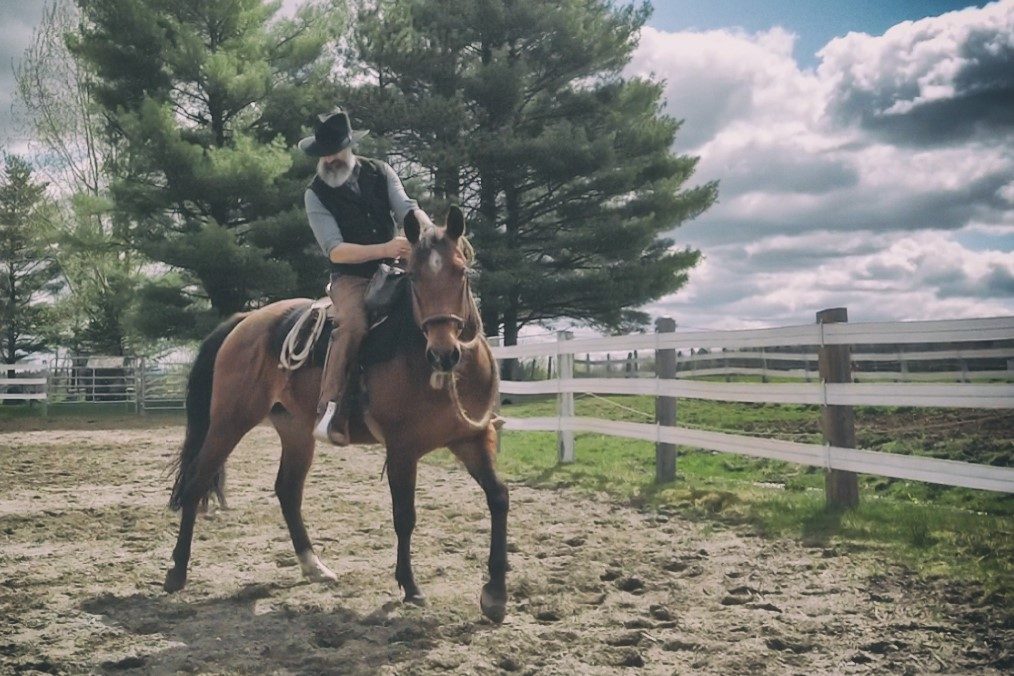The objective is to split the weight of your horse equally on each quarter, working its balance. First, the short serpentine to find rhythm, then the open serpentine to find harmony and feel.
Table of Contents
There are two types of serpentines: short and long. Short serpentines have undoubtedly an important role in helping the horse to find his balance, and to improve softness. Yet, the serpentines are, on my mind, much more important in building the relationship.
Short serpentines will teach the riders to feel their horses, to consider them as a part of their body. Long serpentines will teach the horses to feel their riders, to consider them as part of their mind.
Position
You should remain in position 2 all the time. Your hands are wide spread for the short serpentines in order to pick the feet at the right moment and change directions easily. On the contrary, your hands should remain still for the long serpentines.
Position of the legs is the key parameter for theses exercises: indeed, serpentines will educate the horse to listen to your legs, that is why you have to be very particular. You should have already taught your horse to untrack his hind legs by applying your heel on the back of his flank, so this part will be easy as your horse will recognize it. You now add a new cue with your outside leg: you should bring it by your horse’s elbow to push his front leg away.
Try to figure your horse as a canoe instead of a car. When you want to turn right, you do not pull on the right rein to bring the front and leave the hind where it is. You should actually push the hind to the left, and push the front to the right, your legs acting as a pair of scissors: right leg pushing the hind end away, left leg pushing the front end away. This, combined to the forward motion, will make the horse turns smoothly to the right. Vice-versa for the left turn of course…

Process | Short serpentines
Pick a straight line in the arena, switch to position 2 to walk your horse, and take some time to feel his rhythm. That is the most important part of the process, your ability to synchronize with your horse will radically change your way of riding. Pay attention to the position of your horse’s legs and the direct relationship with the position of your hips. Typically, you should feel your right hip going up and forward when your horse’s right front leg leaves the ground. Start from here to get the rhythm, to match the motion of your body to your horse’s legs.
Once you are in cadence with your horse, pick the right rein exactly when the right front foot leaves the ground, open your hand to the outside, and release the rein. This very tiny little thing makes huge changes in your riding as this rein-picking right in time with its rhythm will mean something to your horse: the rein is directly connected to the foot, your action is not stuck in his mouth but flawlessly goes through his body down to his feet. The consequence of this good timing is your horse raising his right foot, moving it to the outside, and laying it to the ground.
Will you get it at once? NO! So, be patient and consistent, do not try to force it, but try to feel it. Pretty soon, you will pick one step right every two or three steps. Later, you will pick two steps right in time every three or four steps. Finally, you will miss only one or two steps from time to time… When you can pick the foot right in time once in a while, change direction and repeat the process. There is a lot of information, so do not try to do it all at the same time. First, feel the rhythm, then pick the reins in cadence, next position your legs.
The objective of the short serpentines is to walk a balanced horse, which means both ends move at the same speed and rate: in the right serpentines, you pick the right rein in cadence with the right front foot leaving the ground (your left leg comes and pushes the outside elbow in the same rhythm), and you push the hind legs to the left by applying pressure with your right heel, so the right hind leg will come up and forward under the horse, crossing with the left hind leg.
As I said, that is a lot of information. Please, take the time to read this over and over until you figure every step and apply them by successive layers. If you try to do everything at the same time, you may get lost and your horse will get confused.
Tip:
Sequence.
1 ) Your right hip goes up and forward = horse’s right front foot leaves the ground
2 ) You pick up the right rein = horse keeps his foot in the air
3 ) You open your hand to the outside = horse brings his foot to the outside
4 ) You release the rein = horse puts his foot down to the ground

Tip: Learning process. Serpentines being much more than random zigs and zags, you should proceed step by step. First, pick the rhythm on a straight line; second, pick the right foot in full circles until you do not miss any steps; third, change direction and pick the left foot in full circles until you do not miss any steps; fourth, position your legs to walk the circles in cadence with your horse; last, change direction every half circle, picking the rein in time and switching the position of your legs adequately. Process | Long serpentines
Long serpentines are technically less demanding, and just require patience and understanding. Pick a straight line in the arena, do nothing with your hands, position your legs to ask for a right turn, and leave some time to your horse to feel them. If nothing happens, pick your right rein in rhythm and pull the right foot to the outside, then release your hand and ask a left turn with your legs only. Same process, if nothing happens, pick up the left rein and bring your horse’s left foot to the outside, release and change direction.
After a while, your horse will assimilate the position of your legs to the picking of the rein coming right after and the necessity to turn. Pretty soon, you will not need to touch your reins anymore, legs will do the job. Duller horses may need a firmer second deal, you can actually bump gently into your horse’s elbow to move it away from pressure, then make sure you stop bumping as soon as your horse turns as expected.
Tip:
A way of riding. These leg cues should not just be an exercise, but a real different way of riding. Whenever you hit the trail, ask your turns with the legs first, keep your hands as a second deal.
Q&A
What if my horse does not turn and start to chew his bit?
It can happen that your horse does not turn as you ask and start to play with the bit. Most of the time, people start to use nosebands and other torture devices not to see the distress of the horse. If that happens, it just means that your cue is stuck in the mouth, that it does not go through the body down to the feet. The reason of that jam in your horse’s mouth is probably your poor timing.
That is why feeling the rhythm is very important: pick too soon and your horse’s foot is planted in the ground, unable to move; pick too late and his foot is already on its way down, unable to move, you might just make your horse stumble. Hence, your rein cue can not flow out of the mouth down to the feet and it stays there, in the mouth. So, make sure your timing is good, in harmony with your horse’s rhythm, and you will prevent this bit-chewing issue.
What if my horse has no rhythm?
First, question yourself: is that your horse that has no rhythm or is that you who can not pick it? Rhythm is not just a mechanical issue, it requires feel, time and balance, which are not easy to get. Yet, having said that, some horses may not be able to get into a rhythm.
The reason will be physical nine times out of ten. Checking the hooves should be the first reflex: Is there any sensitivity at the back of the foot (contracted heels, poor frogs eaten by thrush, etc.)? Is the sole strong enough (shallow grooves would be a good marker)? Shoed horses being more prone to hoof diseases, you should double-check the feet too. Sometimes, when hooves are all clear, you may ask your veterinarian or osteopath to look for pinched ligaments or torn muscles. Make sure your horse is physically fit to respond to such exercises.
